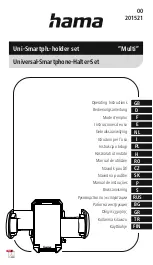
MSP-070C Battery Maintainer
3
Safety Guidelines
For safe, efficient, and accurate charging and testing, review the
safety and operating instructions in this manual before using the
analyzer. In addition, follow all manufacturers’ instructions and BCI
(Battery Council International) safety recommendations.
1 General Safety Precautions
Risk of explosive gases
Batteries generate explosive gases during normal
operation, and when discharged or charged.
1.1 To reduce risk of battery explosion, follow these safety instructions
and those published by the battery manufacturer and the manu-
facturer of any equipment you intend to use in the vicinity of a
battery. Review cautionary marking on these products and on the
engine, and on the vehicle or equipment containing the battery.
Charging a non-rechargeable battery may
cause the battery to burst.
To reduce the risk of injury, only charge rechargeable
lead-acid type batteries including maintenance-free,
low-maintenance, or deep-cycle batteries.
If you are uncertain as to the type of battery you are attempting
to charge, or the correct procedure for checking the battery’s
state of charge, contact the seller or battery manufacturer.
1.2 Use of an attachment not recommended or sold by the battery
charger manufacturer may result in a risk of fire, electric shock, or
injury to persons.
1.3 To reduce risk of damage to the electric plug and cord, pull by the
plug rather than by the cord when disconnecting the charger.
1.4 Position the AC and DC leads to avoid tripping over them and to
prevent damage from moving engine parts; protect from heat,
oil, and sharp edges.
1.5 Do not operate the charger if it has received a sharp blow, been
dropped or otherwise damaged in any way; take it to a qualified
service center.
1.6 Do not disassemble charger; take it to a qualified service center
when repair is required. Incorrect reassembly may result in a risk
of electric shock or fire.
1.7 To reduce risk of electric shock, unplug the charger from the AC
outlet before attempting any maintenance or cleaning. Turning
off the controls will not reduce this risk.
1.8 Connect and disconnect the battery leads only when the AC
supply cord is disconnected.
1.9 Do not overcharge the battery.
1.10 Charge the battery in a dry, well-ventilated area.
1.11 Never place articles on or around the charger, or locate the charger
in a way that will restrict the flow of cooling air through the cabinet.
1.12 An extension cord should not be used unless absolutely neces-
sary. (See paragraph 4.2)
1.13 Have a damaged cord or plug replaced immediately.
1.14 Do not expose the charger to rain or snow.
2 Personal Precautions
2.1 The MSP-series chargers are not to be used by people with re-
duced physical, sensory or mental capabilities, or lack of experi-
ence and knowledge, unless they have been given supervision
or instruction.
2.2 Children should be supervised to ensure they do not play with
the appliance
2.3 Always have someone within range of your voice, or close enough
to come to your aid, when working around lead acid batteries.
2.4 Have plenty of fresh water and soap nearby in case battery acid
contacts skin, clothing or eyes.
2.5 Wear complete eye protection, clothing protection, and wear
rubber soled shoes. Place damp cloth over battery to protect
against acid spray. When ground is very wet or covered with
snow, wear rubber boots. Avoid touching eyes while working
near battery.
2.6 If battery acid contacts skin or clothing, wash immediately with
soap and water. If acid enters the eye, immediately flush with
cold running water for at least 10 minutes, and seek medical at-
tention.
2.7 NEVER smoke or allow a spark or flame in vicinity of a battery or
engine.
2.8 Be extra cautious to reduce risk of dropping a metal tool onto
the battery. It might spark or short circuit the battery or other
electrical part that may cause an explosion.
2.9 Before working with a lead-acid battery, remove personal metal
items such as rings, bracelets, necklaces, watches, etc. A lead-
acid battery can produce a short circuit current high enough to
weld such items causing a severe burn.
Non-rechargeable batteries may burst when
charging causing personal injury and damage.
To avoid electrical shock or burn, never alter the char-
ger’s original AC cord and plug. Disconnect plug from
outlet when charger is idle.
The charger is not intended to supply power to a low-voltage
electrical system other than applications using rechargeable,
lead-acid type batteries. Do not use the battery charger
for charging dry-cell batteries commonly used with home
appliances. These batteries may burst and cause personal injury
and property damage.
2.10 NEVER charge a frozen battery; thaw it out first.
3 Preparing To Charge The Battery
3.1 If it is necessary to remove the battery from vehicle to charge
it, always remove the grounded terminal from the battery first.
Make sure all accessories in the vehicle are off, so as not to cause
an arc.
3.2 Be sure the area around the battery is well ventilated while the
battery is being charged. Gas can be forcefully blown away by
using a piece of cardboard or other nonmetallic material as a fan.
3.3 Clean the battery terminals. Be careful to keep corrosion from coming
into contact with your eyes.
Safety Guidelines

























